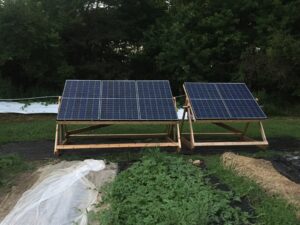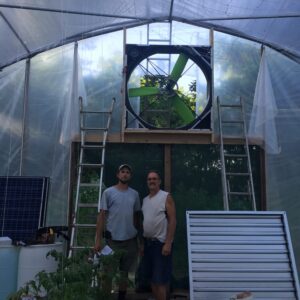Final Report for FNC16-1059
Project Information
The Farm at Kraut Run received a high tunnel grant through the USDA NRCS program in July of 2013. We have been producing crops inside the high tunnel year round since it was constructed. Vegetable production inside the high tunnel during late spring and summer has been a struggle due to excessive heat and humidity which results in undue plant stress and overall poor growing conditions. The farm resides in a creek bottom where natural ventilation is limited and therefore ventilation inside the environment of the high tunnel is very poor. We have seen a variety of fungal diseases develop inside the high tunnel on crops including lettuce, kale, tomatoes, peas, and carrots. We also have experienced very poor tomato production inside our high tunnel due to blossom drop as a result of high heat and humidity. We planted an earlier crop of determinate tomatoes in 2015 in attempt to avoid the hottest part of the season, but the excessive spring rainfall and early heat produced the same results.
In communicating with our NRCS agent and several other high-tunnel growers, we have found that most high tunnels in our area are out of production during the warm season. The small size of our farm limits our ability to forego using the area covered by our high tunnel. The stated goals of the USDA NRCS High Tunnel Initiative include ‘extending the growing season’ and ‘improving plant quality’, however, the warm season conditions inside most high tunnels runs counter to those goals.
Introduction:
The Farm at Kraut Run is a 10 acre organic farm that is used for vegetable, hog, and chicken egg production. In our vegetable gardens we utilize a no-till, permanent raised bed strategy that focuses on soil health and diversity to produce high quality produce. We grow most common varieties of vegetables with a focus on heirlooms. We also raise hogs for high quality pork products. We frequently move our hogs using electric fencing to get as much natural forage into their diet as possible. Our chickens are used for egg production and are free-ranged for natural foraging.
We have always operated a very sustainable operation with most of the soil work done by hand and very little fossil fuel use as we have no large equipment (tractors, etc…). We attempt to use as few inputs as possible by making our own compost (our sole fertilizer) and potting mix. Wherever it is necessary to purchase inputs we opt for the most sustainable products we can find.
Our goal was to create an environment inside the high tunnel that was adaptable to year-round production, primarily focusing on warm season production, as most high tunnel producers forego summer production due to unfavorable growing conditions as a result of high heat and humidity inside the tunnel. This is especially problematic for a small operation such as ours as we do not have the amount of ground that would allow us to let our high tunnel lay fallow during the summer. Many producers have added high tunnels to their operation in recent years and we hope to create a viable model for year-round high tunnel production.
Cooperators
Research
The first step in conducting our project was to design and install a ventilation system that would exhaust/exchange enough air to create an optimal growing environment. With a focus on sustainability, we wanted to design a system that was completely solar-powered. Solar power is a perfect fit for this project as we needed to create the most air movement during the hottest, sunniest days. We consulted with Sunshine Works in Tennessee to design our system and ultimately purchase the necessary components. The fans that we used were manufactured by Snap Fan and we used their air movement (CFM) specifications to determine the sizes and quantity of fans needed. For our 30’x96’ high tunnel we installed 2 50” exhaust fans, one in each end wall, to exhaust air from the tunnel. These are very large fans that required robust end-wall framing to support them (instructions/specifications were supplied from the manufacturer). Additionally, we installed 6 horizontal air flow (HAF) fans, 3 on each side of the tunnel, to circulate air within the high tunnel. Our high tunnel has roll down sidewalls which would allow fresh air to be drawn into the building. The system required a total of 5 solar panels, one for each 50” fan and one for every two HAF fans. We constructed mounting racks for the panels out of exterior grade lumber that could be rotated, based upon the level of the sun, for highest efficiency. The system was wired directly from the solar panels to each fan using 10 gauge insulated copper wire inside UV resistant conduit. We used Helios H4 solar connectors to connect the wiring at each fan. Thermostat switches were installed for the 50” exhaust fans so that they did not operate when temperatures were cold. The system installation took most of the first year to complete as we did not have it fully operational until November of 2016.


The second step in our project was to obtain as much crop data and temperature/humidity analysis as possible to determine the effectiveness of the ventilation system. This was to be the focus of the second year of our project. Unfortunately, our farming business collapsed due to financial strains and we were unable to complete the second year of the project.
As we fell short of our goal for this project, we did not obtain substantial crop data and analysis. We were unable to measure the effectiveness of our system on the temperature and humidity inside the high tunnel or obtain crop yields for the 2017 growing season. However, based on our experience working inside the high tunnel before and after the system was installed, we can empirically state that the air movement inside the high tunnel was dramatically improved, and therefore we suspect that it would have a profound effect on crop yields. During the 2016 growing season, we planted a 90’ row of parthenocarpic cucumbers (3 different varieties, Diva, Excelsior, and Tasty Jade) inside our high tunnel. We experienced early heat and high humidity in late spring and as a result we were losing approximately 75% of the crop as the majority of the blossoms dropped without producing any fruit. We were able to install 3 HAF fans along the same side of the high tunnel by early summer and enough of the solar panels to power them. Once the fans were installed and moving air along our cucumber crop, the yields improved tremendously. We were still experiencing approximately 30% loss of fruit but the full compliment of fans was not installed until the crop was finished. We suspect that yields would have improved even further with the complete system in operation. It is likely that we would have seen the same yield improvements with tomatoes planted in the high tunnel. We have experienced the same symptoms with tomatoes in previous years as we did with the 2016 cucumber crop. We were also able to realize the benefits of the ventilation system in the colder months. Generally in the colder parts of the year the side walls of the high tunnel remain rolled up to retain warmth. This results in the accumulation of very stagnant air inside the high tunnel which can negatively effect cool season crops as well. The HAF fans are able to keep the air inside the high tunnel circulating while the exhaust fans operated if the temperature inside the high tunnel warmed to the desired thermostat setting. This in turn required one or both of the sidewalls to be opened slightly to allow for fresh air to be drawn into the building. As long as it wasn’t forecasted to get too cold overnight we were able to leave the sidewalls open very slightly and let the fans operate as needed based on the amount of sunlight during the day. Also, with the dramatic changes in day-to-day temperature that we experience in our area we found ourselves having to open and close the sidewalls of the high tunnel very frequently. The addition of the fans and thermostat controls became quite convenient as we did not have to operate the sidewalls nearly as much.
Impact of Results/Outcomes
In summary, we can confidently say that this project would likely have achieved the desired results. We experienced many advantages with this system without even completing an entire growing season with it in operation. The biggest disadvantage to this system is the cost ($12,000 +), which would take several years of production to recoup. However, there is a considerable amount of intangible value with a good crop compared to a bad crop and this system would make working conditions inside the high tunnel much more favorable for the farmer(s).
Educational & Outreach Activities
Participation Summary:
We had planned to work with Reneesha Auboug to conduct a field day in the summer of 2017 to display our project and discuss our findings but our project fell short due to the closing of our farming business.
Project Outcomes
Potential Contributions
We consulted with Joan Benjamin of NCR-SARE and Reneesha Auboug of Lincoln University to formulate our idea for this project. Ron Castle of Sunshine Works was instrumental in the design of our system and guidance during installation. I, Ryan Smith, and my business partner Chris Wimmer were the two farmers involved in the project. My father Craig was a tremendous help in the carpentry work needed to construct the system.
Future Recommendations
We would recommend this system to any high tunnel producer as long as they planned to be in production for the foreseeable future. This system was very costly but had many benefits. A specific cost share or grant program, possibly associated with the EQIP high tunnel initiative, would be a good fit for this type of improvement. Additionally, a similar system that was not solar powered could be installed for considerably cheaper but you would have to weigh the up front costs of a solar system with the long term energy costs of a grid powered system.